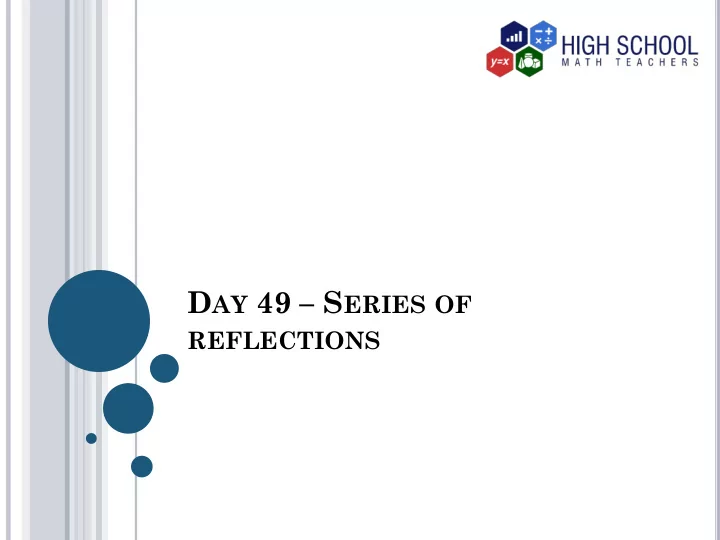

D AY 49 – S ERIES OF REFLECTIONS
I NTRODUCTION At times, a single object may undergo more than one rigid motion. That is, we may have a reflection and a rotation, a reflection and a translation and so on. When all these motions are subjected to one figure, we maybe interested in finding the relationship between the initial pre-image and the final one. Our aim may be to find out if we can describe the relation by just one rigid motion. In this lesson, we are going to explain and illustrate theorems on how successive reflections can be described by only one rigid motion.
V OCABULARY Successive reflection It is a series of reflections through more than one mirror line.
Theorem Successive reflection in two intersecting mirror lines produces a rotation about the point of intersection through twice the angle between the mirror lines. Consider the following illustration where one mirror line is positioned along the y-axis and the other one along the x-axis. The two mirror lines intersect at the origin, and their angle of intersection is 90 ° .
y 𝐶′ 𝐶′′ 𝐵′ 𝐵′′ 4 2 𝐷′ 𝐷′′ -6 -4 -2 0 2 4 6 x C -2 -4 A B
∆𝐵𝐶𝐷 is reflected over the x-axis to ∆𝐵 ′ 𝐶 ′ 𝐷′ then ∆𝐵 ′ 𝐶 ′ 𝐷′ is reflected over the y-axis to ∆𝐵 ′′ 𝐶 ′′ 𝐷 ′′ . ∆𝐵𝐶𝐷 can be mapped to ∆𝐵 ′′ 𝐶 ′ ′𝐷′′ by a rotation of 180 ° about the origin. Thus the two successive reflections have produced a rotation about the point of intersection of the two mirror lines and through twice the angle between the mirror lines.
Theorem: Successive reflection in parallel mirror lines produces a translation in a direction perpendicular to the mirrors through a distance equal to twice the distance between mirrors. Consider the following illustration where ∆𝑁𝑂𝑃 is in between two mirror lines one mirror line at the line 𝑦 = 0 and another one at the line 𝑦 = 4 .
. y 4 O 𝑃′′ 𝑃′ 2 M N 𝑁 ′′ 𝑂 ′ 𝑂′′ 𝑁′ -7 -6 -5 -4 -3 -2 -1 0 1 2 3 4 5 6 7 x -2 -4
∆𝑁𝑂𝑃 is reflected over the line 𝑦 = 4 to ∆𝑁′𝑂′𝑃′ then ∆𝑁′𝑂′𝑃′ is reflected to ∆𝑁 ′′ 𝑂 ′′ 𝑃 ′′ . Note that the distance between the two mirror lines is four units and a translation of eight units to the left can map ∆𝑁𝑂𝑃 to ∆𝑁 ′′ 𝑂 ′′ 𝑃 ′′ . Thus, successive reflection in parallel mirror lines produces a translation in a direction perpendicular to the mirrors through a distance equal to twice the distance between mirrors.
Theorem: Any rigid motion of the x-y plane can be written as a composition of no more than 3 reflections. From the first theorem of this lesson, we found that successive reflection in two intersecting mirror lines produces a rotation about the point of intersection through twice the angle between the mirror lines. Thus any rotation can be written as two successive reflections by two mirror lines intersecting at an angle half the angle of rotation.
A translation can be written as two reflections with mirror lines at each side of the original object and the distance between the mirror lines being half the distance between the original object and the image. See the following illustration.
. y 4 2 -6 -4 -2 0 2 4 6 x -2 -4
The green rectangle has been translated four units to the left. This translation can be written as successive reflection by two parallel mirror lines two units apart; one at the line 𝑦 = 1 and another one at the line 𝑦 = −1.
Example Two perpendicular mirror lines intersect at a point T 2,3 . If a triangle is successively reflected by the two mirror lines, describe a rotation that can map the final image of the triangle and original triangle. Solution A rotation of 180 ° about the point T 2,3
HOMEWORK A vertex of a triangle is at a point S −4,2 . The triangle is translated horizontally such that point S is mapped to the point T 4,2 .If two parallel mirror lines can map S and T and one of the mirror line is at the line 𝑦 = −5 , What is the equation of the other mirror line?
A NSWERS TO HOMEWORK 𝑦 = −1
THE END
Recommend
More recommend